Easy Bison Meatballs are sure to become a regular dinner in your menu plan! These are incredibly easy to whip up, and have a wonderful savory flavor and tender texture. Say hello to your new favorite meatball recipe.

An Easy Way to Use Ground Bison!
Are you interested in cooking with ground bison? This wholesome red meat is becoming more and more widely available in the U.S., and it’s so tasty and easy to work with. I totally recommend trying ground bison in your favorite recipes. This easy meatball recipe is one of our favorites, and if you make it, I’m sure you’ll see why!
I like to serve my meatballs with Rao’s marinara sauce. It’s a natural pair – tender, moist, flavorful meatballs and savory marinara? Um, yeah. Count me in! Add some salad and pasta, and dinner is done. Plus, thanks to using sweet potato instead of breadcrumbs and milk, this recipe is paleo, Whole30, dairy-free, and gluten-free!
Why You’ll Love These Ground Bison Meatballs
- They Are Simple to Make! You only need some basic ingredients and a few minutes of your time to make bison meatballs. This is a totally un-fussy recipe, perfect for busy weeknights.
- Bison Is a Healthy Protein. Protein is important for healthy muscles, bones, hormone production, and more. Bison is a great choice for getting some protein in your diet – it’s lean, flavorful, and high in iron.
- Meatballs Are Versatile. Meatballs work beautifully with marinara, rice, salad, or whatever else you want to pair them with. Dunk them into sauce, throw them into a sandwich, you can’t go wrong!

Recipe Ingredients
While some meatball recipes include a whole laundry list of ingredients, this one is actually very simple. You won’t need to gather an armload of ingredients to make this – just a few basics:
- Bison: Ground bison is the number-one ingredient here. You may be able to find this locally, but if not, you can also order it online.
- Garlic: One clove, minced. Feel free to add an extra clove if you like things extra garlicky! If you like, you could substitute garlic powder instead.
- Onion: One small yellow onion, peeled and grated. Once you grate the onion, place it on a paper towel or a clean kitchen towel, and squeeze it out so that it’s dry instead of watery.
- Sweet Potato: Peel the sweet potato, and grate it as well.
- Parsley: Chopped fresh parsley. Dried parsley will also work, if you prefer.
- Egg: A beaten egg helps bind the mixture together.
- Tomato Paste: Be sure to use tomato paste, not tomato sauce – tomato sauce is much more liquidy and won’t add the right flavor.
- Red Pepper Flakes: For just a little heat. We love this addition, but you can leave it out if you don’t want that touch of spiciness.
- Sea Salt: Or whatever salt you like.

How Does Bison Taste?
In general, you can expect a definite “red meat” taste when you eat bison. It is high in iron, which gives it a definite “earthy” flavor like your favorite beef or venison. However, it’s also known for its light taste. It is much less “gamey” than meats like venison, and lots of people think it is even milder and sweeter than beef, especially grass-fed beef. If you want to include red meat in your diet, but you don’t like an overly strong taste, try bison!
Is Bison Better Than Ground Beef?
Bison and beef can both be good, healthy options. They both have great protein, iron, and micronutrient profiles. So why choose bison? For one thing, using bison instead of beef now and then adds variety to your diet. Bison is also…
- Leaner. Bison is less fatty than beef in general, which makes it a lower-calorie option (good for those who are watching their calories). However, it’s still known for its flavor and tenderness, even though it is lean. Win-win!
- Grass-fed. For the most part, bison is grass-fed, so if you are looking to add more grass-fed meat to your diet, this is one way to do that!
- Omega-3s: Balancing the number of Omega-6 fatty acids and Omega-3 fatty acids is important, and most beef is higher in Omega-6s. You can grab some extra Omega-3s (compared to beef) by using bison now and then.
- Fewer Antibiotics and Hormones: Beef cattle are often given antibiotics and hormones to keep them from disease and promote growth. Bison is usually free from antibiotics and hormones, so if that’s something you’re looking for, check it out!

How to Make Bison Meatballs
Okay, let’s get into the cooking process. It’s actually really easy! Especially since these meatballs are baked. You will not have to stand over a frying pan turning them – just let the oven do the work.
- Get Ready to Bake. First of all, set your oven to preheat to 375°F. That way, when the meatballs are ready, they can go straight into the hot oven. Then line your baking sheet with parchment paper for easy cleanup (this is optional, of course).
- Make the Meatball Mixture. Next, place all of the ingredients except marinara in a mixing bowl: ground bison, garlic, onion, sweet potato, parsley, egg, bread crumbs, hot sauce, ground black pepper, and a pinch of salt. Mix with your hands (or a spoon, if you prefer) until evenly blended. But don’t overmix, or the meatballs will be tough.


- Form the Meatballs. Working with a couple of tablespoons at a time, roll the meatball mixture into 2-inch balls, and place them on the baking sheet about an inch apart.
- Bake! Place the baking sheet in the oven, and bake the bison meatballs for 15 minutes or until done through (see the Tips section for more on doneness).
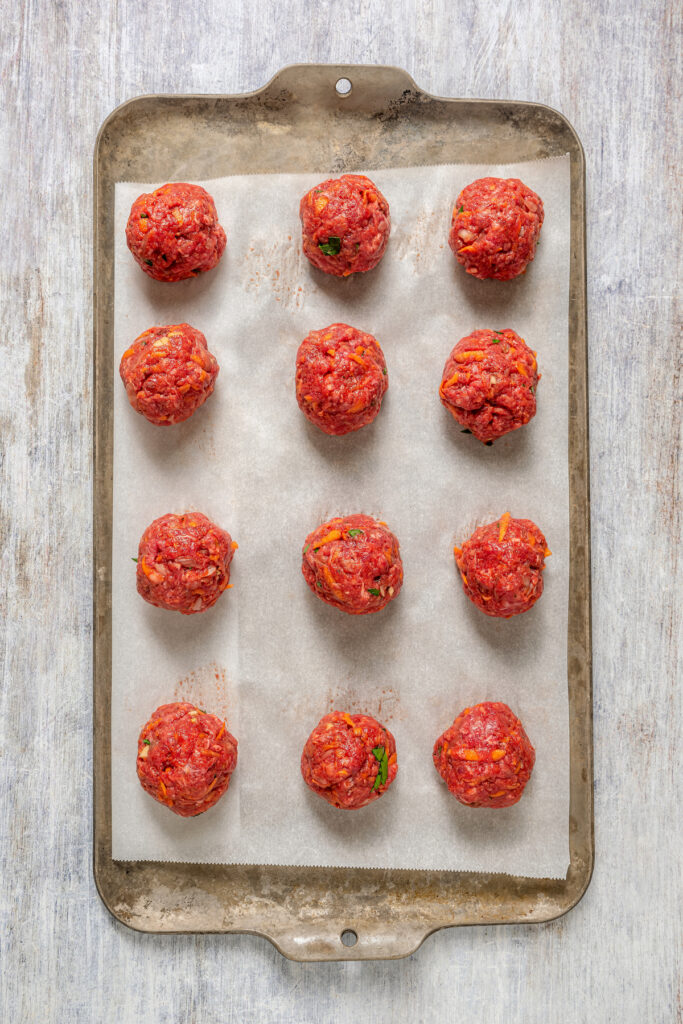

- Enjoy! Serve the meatballs with your favorite marinara sauce, or other dishes and sides.
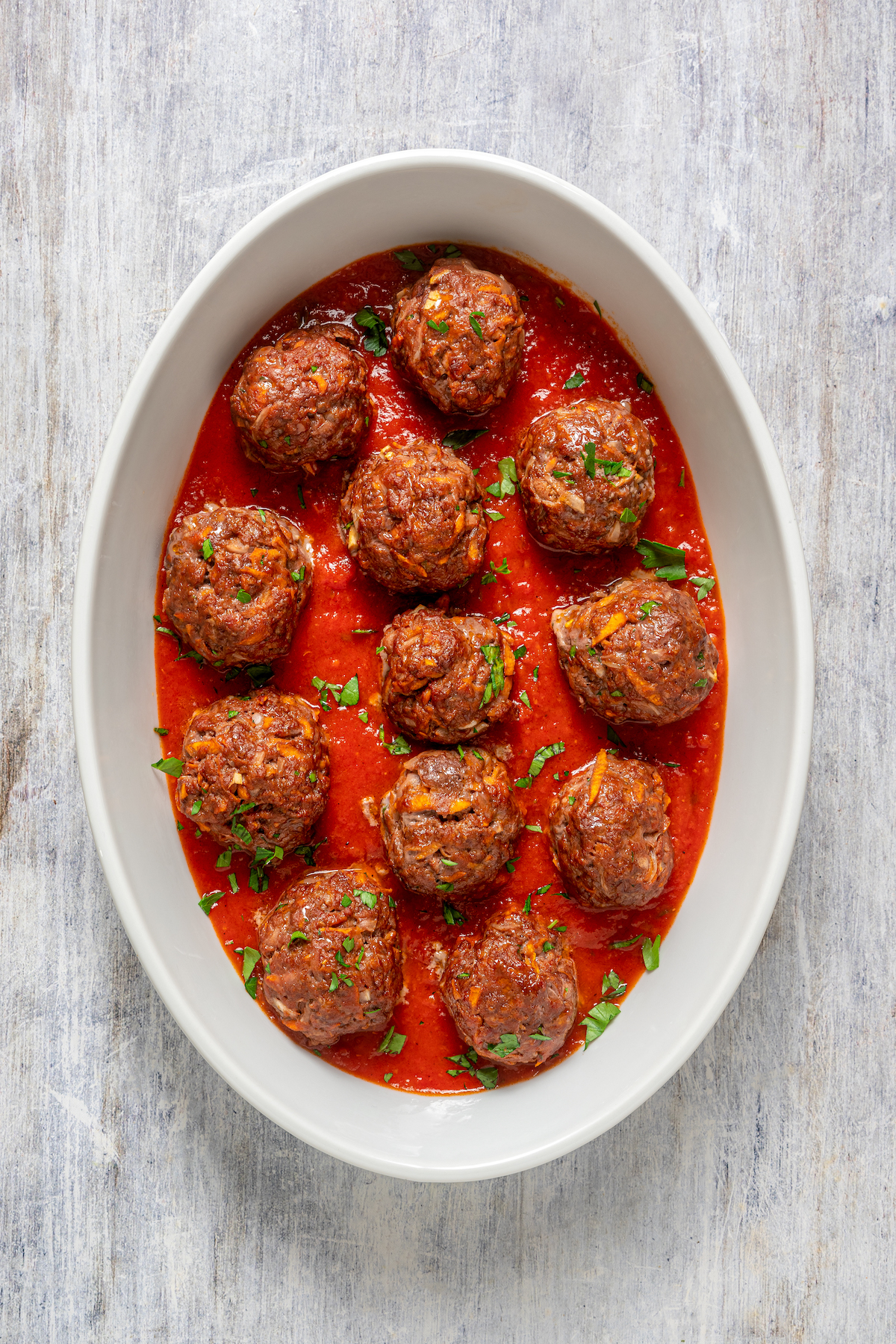
Tips for Success
I have quite a few tips here for making really good bison meatballs, so be sure to check them out! These will help make your dinner that much more delicious.
- Doneness: It’s important to make sure your bison meatballs are cooked through without overcooking them. The easiest way to do that? A meat thermometer! The internal temperature of the meatballs should be about 160 – 165°F.
- Use Cold Bison and Wet Hands: Forming meatballs can be a little tricky. Two things that make it easier? Using cold meat right out of the fridge, and wetting your hands with water to prevent sticking.
- Grating the Veggies: You might be tempted to just finely chop the onion and sweet potato instead of grating them, but grating really is better. Grated onion and sweet potato almost dissolve in the meatball mixture, flavoring the meat and adding tenderness. Chopped veggies, even if they are fine, will create a more chunky texture.
- Form the Meatballs Gently: Any time you are working with ground meat, including ground bison, handle it gently and don’t pack the meatballs tightly or overwork the mixture. Tightly packed or overworked meatballs tend to be tough, while loosely-rolled, gently-mixed meatballs are more tender.
- Make-Ahead (Fridge): While you can find storing and freezing guidelines for cooked meatballs below, it’s great to know that these can also be stored or frozen uncooked, if you just want to do some quick prep and then cook them at a later date. To store in the refrigerator, form the meatballs and then place them in an airtight container in the fridge for up to two days.
- Make-Ahead (Freezer): To freeze uncooked bison meatballs, place the formed meatballs in the freezer on a clean cookie sheet, not couching until frozen solid. Then package them in freezer bags to freeze for up to three months.
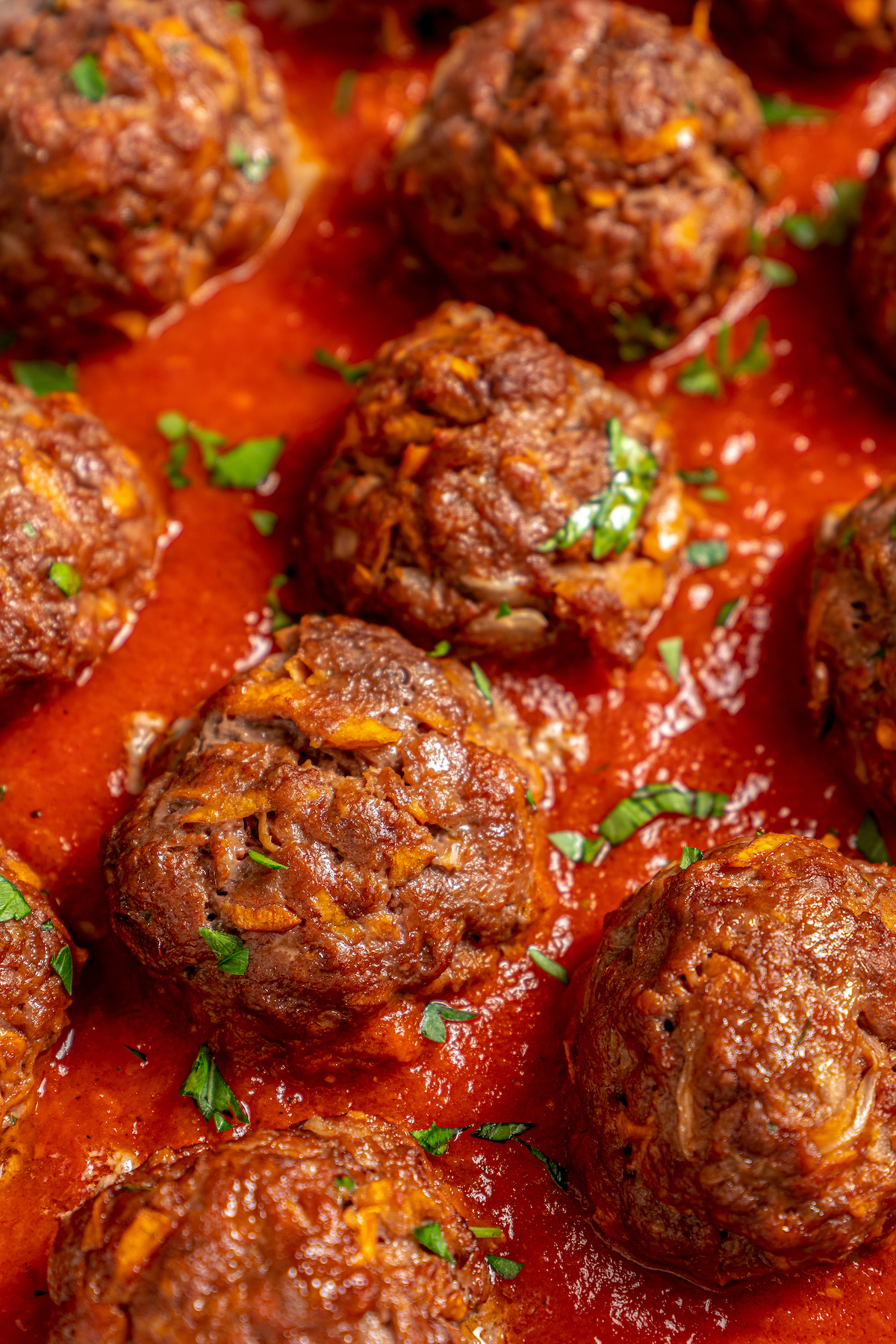
Serving Suggestions
Bison meatballs can be served in so many ways! Pile them onto hoagie rolls, pack them into a bento box for lunch, or just serve your meatballs and sauce over pasta. Yum. These side dishes also go well with bison meatballs:
- Orzo Salad: If you make the meatballs without sauce, add them to this Wild Rice Orzo Cranberry Salad – what a combination! It makes a really great lunch or light dinner, packed with nutrition but not too rich.
- Brussels Sprouts: We can’t get enough of these Simple Spicy Roasted Brussels Sprouts! They are easy to make, and have the perfect amount of caramelization, crisp-tender texture, and heat.
- Sweet Potatoes: Sweet potatoes are so flavorful naturally that you can simply bake them and serve with a little butter (or not) and they’ll be delicious. But if you want to go all-out, this recipe for Mashed Sweet Potato with Bourbon Glaze is one dish that will have you craving more!

How to Store and Reheat Bison Meatballs
You can store bison meatballs in the refrigerator for 3 – 4 days, sealed in an airtight container or food storage bag. Be sure to cool the meatballs down before you store them, for best results. You don’t need to (and shouldn’t) leave them out much longer than one hour, but do let them cool a bit before you package and store.
To reheat these meatballs, I like to place them in a covered saucepan or skillet and reheat on low to medium heat. If they seem dry, add a splash of broth or water. This will help keep them moist.
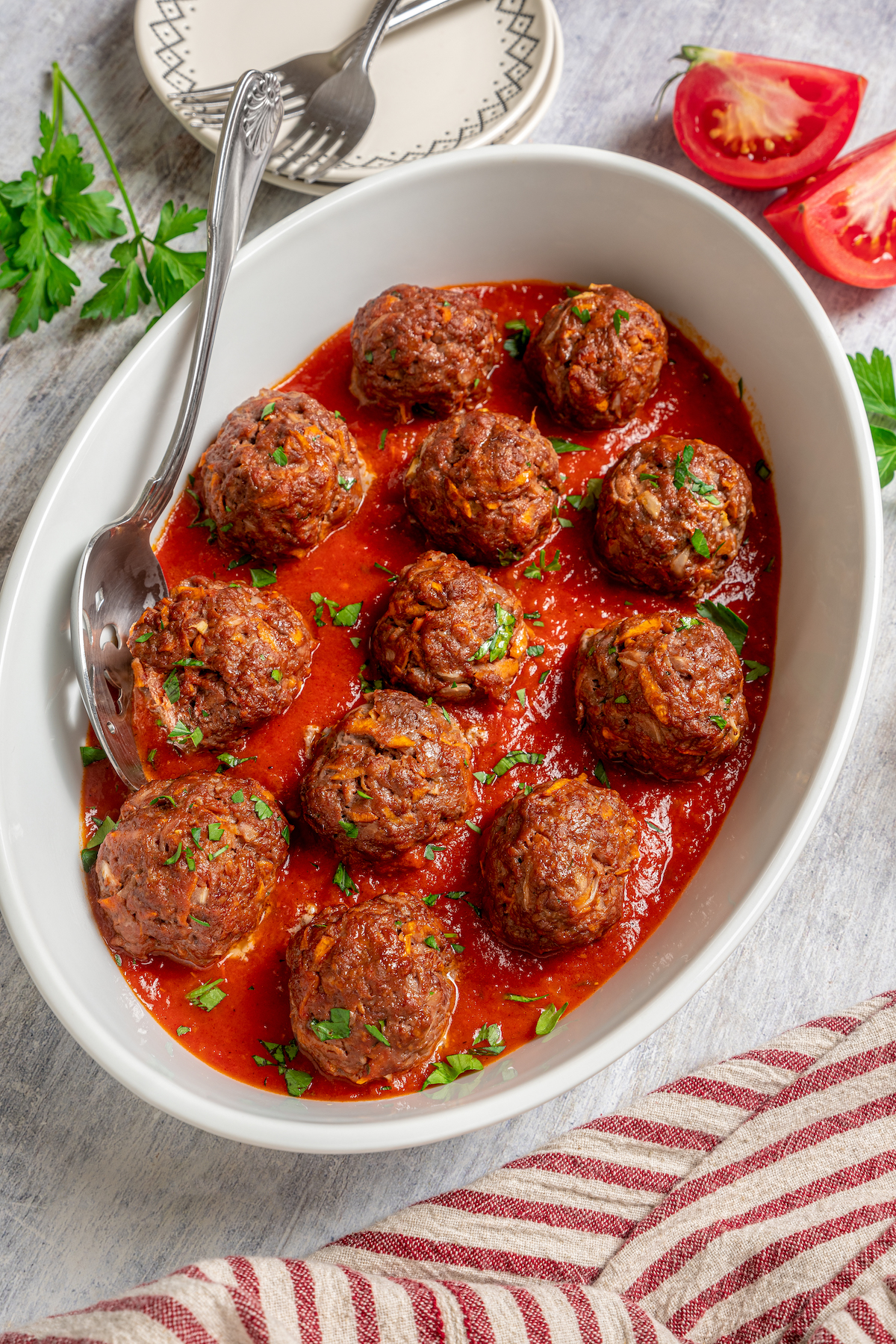
Can I Freeze These?
Yes, you can freeze bison meatballs for longer storage! In fact, you may want to make a double-batch of these so that you can freeze half for another meal later in the month. To freeze them successfully, cool the meatballs down, and then pack them into a freezer container or freezer bag. Mark with the date, and freeze for up to 3 months.
If you want to freeze the meatballs so that they’re easier to take out and thaw a few at a time, try flash-freezing them first. Place the meatballs on a cookie sheet or plate, and freeze until frozen solid. Then place the frozen meatballs in your container or freezer bag. They will stay more or less separate this way, instead of freezing in one big clump!
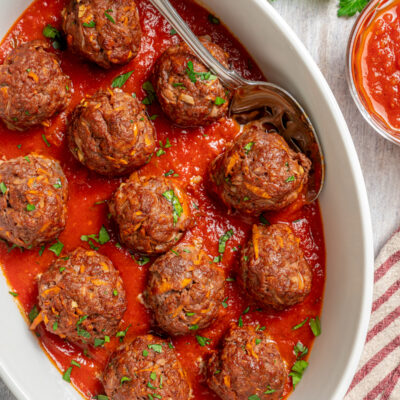
Bison Meatballs
Ingredients
- 1 pound ground bison
- 1 garlic clove minced
- 1 small yellow onion cooked then peeled and grated 1/3 cup, place onion in a paper towel and gently squeeze to remove excess fluid.
- 1 small sweet potato COOKED, peeled and grated about 3/4 cup (directions for cooking below)
- 2-3 tablespoon parsley chopped
- 1 egg
- 1/3 cup gluten free panko breadcrumbs
- 1 tablespoon hot sauce
- 1/2 teaspoon ground black pepper
- 1 teaspoon of sea salt
- RAO marinara or another sugar free marinara sauce
Instructions
- Preheat oven to 375°F.
- Line baking sheet with parchment paper.
- Place all ingredients in a bowl and blend evenly, using your hands.
- Form into 2” balls and place 1” to 1 1/2” apart on a baking sheet.
- Bake for 15 minutes.
- Serve with marinara sauce.
How to cook sweet potato
- Wash, pat dry and pierce sweet potato with fork all over.
- Place sweet potato on microwave safe plate and microwave for 5 minutes. Turning halfway through.
- Your sweet potato should be for tender, if not cook an additional 30 seconds.
- Peel potato and mash or grate for meatballs
Notes
- Doneness: It’s important to make sure your bison meatballs are cooked through without overcooking them. The easiest way to do that? A meat thermometer! The internal temperature of the meatballs should be about 160 – 165°F.
- Use Cold Bison and Wet Hands: Forming meatballs can be a little tricky. Two things that make it easier? Using cold meat right out of the fridge, and wetting your hands with water to prevent sticking.
- Grating the Veggies: You might be tempted to just finely chop the onion and sweet potato instead of grating them, but grating really is better. Grated onion and sweet potato almost dissolve in the meatball mixture, flavoring the meat and adding tenderness. Chopped veggies, even if they are fine, will create a more chunky texture.
- Form the Meatballs Gently: Any time you are working with ground meat, including ground bison, handle it gently and don’t pack the meatballs tightly or overwork the mixture. Tightly packed or overworked meatballs tend to be tough, while loosely-rolled, gently-mixed meatballs are more tender.
- Make-Ahead (Fridge): While you can find storing and freezing guidelines for cooked meatballs below, it’s great to know that these can also be stored or frozen uncooked, if you just want to do some quick prep and then cook them at a later date. To store in the refrigerator, form the meatballs and then place them in an airtight container in the fridge for up to two days.
- Make-Ahead (Freezer): To freeze uncooked bison meatballs, place the formed meatballs in the freezer on a clean cookie sheet, not couching until frozen solid. Then package them in freezer bags to freeze for up to three months.
- Storage: Store baked, cooled bison meatballs in airtight containers or food storage bags. They will keep for up to four days in the refrigerator, or up to three months in the freezer. Thaw before reheating.









